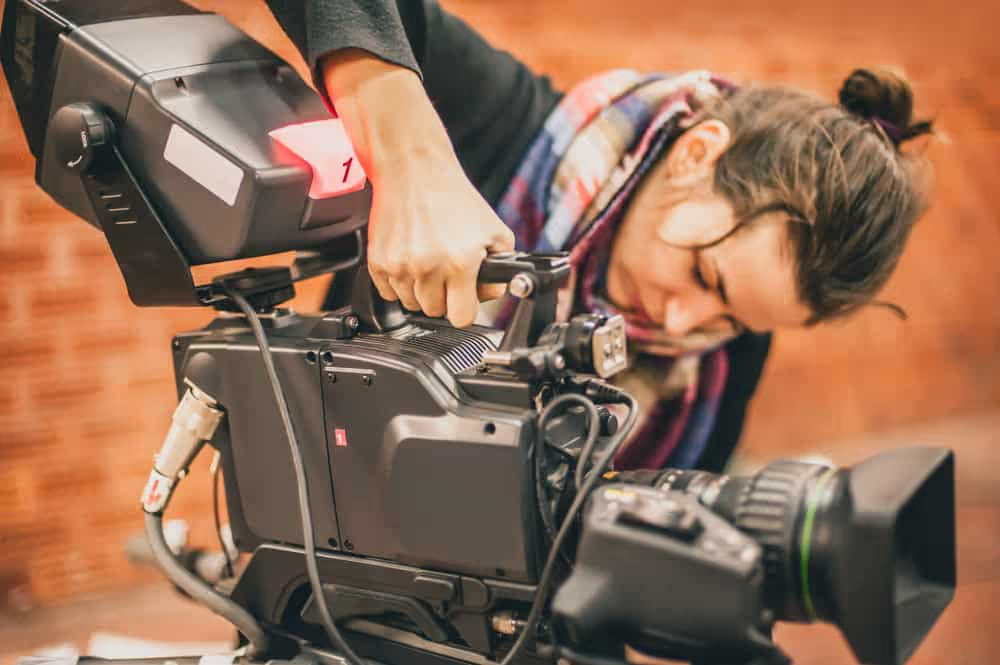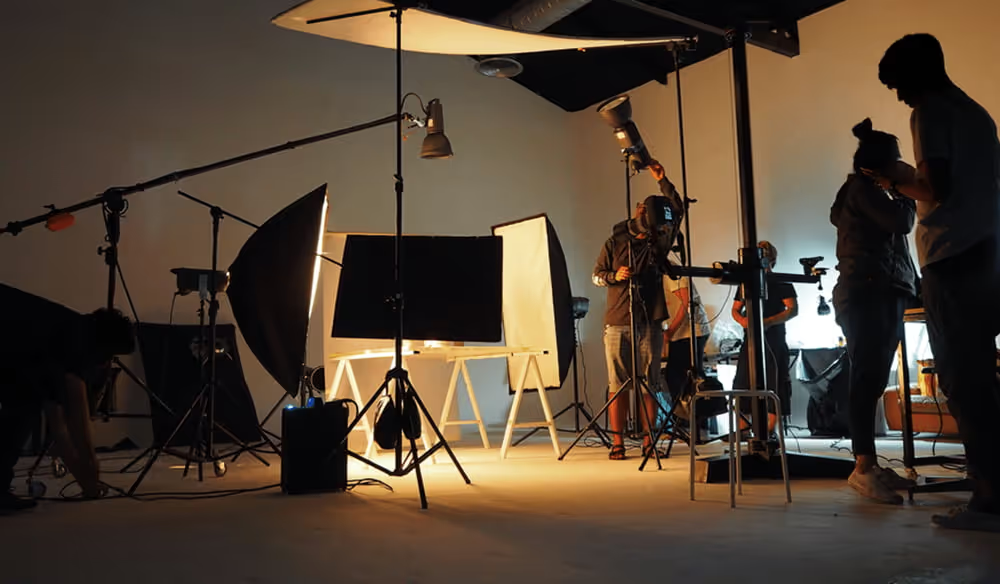Table of Contents
Video is one of the most powerful and popular forms of communication in the digital age. According to a recent report by Cisco, the video will account for 82% of all internet traffic by 2022. This means that if you want to reach your target audience online, you need to create videos that capture their attention and interest.
But how do you create engaging content that stands out from the crowd? What are the elements that make a video compelling and memorable? And how can you leverage the benefits of video production to boost your brand awareness and conversions?
In this blog post, we will explore these questions and more. We will look at the significance of engaging content in video production, the impact of engaging videos on audience retention and brand awareness, some examples of successful campaigns driven by engaging content, and the role of a professional video production crew in creating engaging content.
The Importance of Engaging Content in Video Production
Why is engaging content important in video production?
Engaging content is content that connects with your audience on an emotional level, sparks their curiosity, and motivates them to take action. Engaging content is not just about delivering information, but about telling a story that resonates with your viewers.
Engaging content is important in video production because it can help you achieve several goals, such as:
Increasing your audience retention
Engaging content can keep your viewers hooked until the end of your video, reducing the bounce rate and increasing the watch time. According to YouTube, videos that have a high retention rate are more likely to rank higher in search results and recommendations.
Building your brand awareness
Engaging content can help you showcase your brand personality, values, and mission. It can also help you establish trust and credibility with your audience, as well as generate word-of-mouth and social media buzz.
Driving conversions
Engaging content can inspire your viewers to take action, whether it is to visit your website, sign up for your newsletter, or buy your product or service. According to a study by Wyzowl, 84% of consumers say that they have been convinced to buy a product or service by watching a brand's video.
How to create engaging content for video production?
Creating engaging content for video production is not an easy task. It requires creativity, strategy, and technical skills. However, there are some general guidelines that can help you craft engaging videos, such as:
Know your audience
Before you start creating your video, you need to understand who your target audience is, what their pain points are, what their goals are, and what kind of content they prefer. This will help you tailor your message and tone to their needs and expectations.
Define your objective
You also need to have a clear idea of what you want to achieve with your video, whether it is to educate, entertain, persuade, or inspire your audience. This will help you focus your content and call-to-action.
Tell a story
One of the most effective ways to engage your audience is to tell a story that relates to them. A story can help you create an emotional connection with your viewers, as well as illustrate the benefits of your product or service. A good story should have a beginning, a middle, and an end, as well as a protagonist, a conflict, and a resolution.
Use visuals and audio
Video is a visual and auditory medium, so you need to use both elements to enhance your content. Use high-quality images, graphics, animations, and sound effects to support your message and capture your audience's attention. You can also use music and voice-over to set the mood and tone of your video.
Keep it short and simple
According to a study by HubSpot, the optimal length for a video depends on the platform where you publish it. For example, on Instagram, videos should be around 30 seconds long, while on YouTube they should be around 2 minutes long. However, regardless of the platform, you should try to keep your video as short and simple as possible. Avoid unnecessary details, jargon, or filler words that might confuse or bore your audience.
Examples of engaging content in video production
To illustrate how engaging content can make a difference in video production, here are some examples of successful campaigns driven by engaging content:
Dove Real Beauty Sketches
This campaign by Dove aimed to challenge the perception of beauty among women. The campaign featured a forensic artist who sketched women based on their own descriptions and then based on strangers' descriptions. The result was that the sketches based on strangers' descriptions were more flattering and accurate than the ones based on self-descriptions. The campaign went viral and generated over 114 million views in one month.
Dollar Shave Club
This campaign by Dollar Shave Club introduced its subscription-based razor service with a humorous and irreverent video. The video featured the founder of the company who explained why his razors were better and cheaper than the competitors'. The video used witty jokes, unexpected props, and catchy slogans to entertain and persuade the viewers. The campaign was a huge success and resulted in 12,000 orders in the first 48 hours.
Always #LikeAGirl
This campaign by Always aimed to empower girls and challenge the stereotypes associated with the phrase "like a girl". The campaign featured a social experiment where people of different ages and genders were asked to perform actions "like a girl", such as running, throwing, or fighting. The result was that the older participants performed the actions in a weak and silly way, while the younger girls performed them confidently and proudly. The campaign sparked a global conversation and received over 90 million views.
The role of a professional video production crew in creating engaging content
While creating engaging content for video production is possible with some basic tools and skills, hiring a professional video production crew can make a big difference in the quality and effectiveness of your videos. A professional video production crew can offer you several advantages, such as:
- Expertise: A professional video production crew has the experience and knowledge to handle every aspect of video production, from pre-production to post-production. They can help you with scriptwriting, storyboarding, casting, filming, editing, sound design, and more. They can also advise you on the best practices and trends for video production.
- Equipment: A professional video production crew has access to the latest and most advanced equipment for video production, such as cameras, lenses, lights, microphones, drones, and software. They can use these tools to create high-quality videos that look and sound amazing.
- Creativity: A professional video production crew has the creativity and vision to bring your ideas to life. They can help you craft engaging stories, visuals, and audio that suit your brand and audience. They can also add their own touch of originality and flair to make your videos stand out from the rest.
If you are looking for a professional video production crew who can help you create engaging content for your brand or business, contact us today. We are a team of experienced and passionate video producers who can handle any type of video project. We would love to hear from you and discuss how we can work together to create engaging videos that will wow your audience.
The Process Behind Creating Memorable Videos
Video is one of the most powerful and engaging forms of communication in the digital age. It can convey complex messages, evoke emotions, and create lasting impressions on the viewers. But how do you create a video that stands out from the crowd and remains in the minds of your audience? What are the elements that contribute to video memorability and how can you apply them in your video production process?
In this blog post, we will explore the process behind creating memorable videos, from the pre-production phase to the post-production phase. We will also share some tips and best practices on how to collaborate effectively with your video production crew and clients to achieve memorable results.
Pre-production phase: Planning and conceptualizing memorable video ideas
The pre-production phase is where you lay the foundation for your video project. It involves defining your goals, target audience, budget, timeline, and creative vision. This is also where you brainstorm and develop your video ideas, based on the principles of video memorability.
According to research, video memorability depends on four main factors: novelty, emotion, aesthetics, and relevance. Novelty refers to how original, surprising, or unexpected your video is. Emotion refers to how your video affects the feelings and moods of your viewers. Aesthetics refers to how visually appealing, harmonious, or pleasing your video is. Relevance refers to how well your video relates to your audience's needs, interests, or preferences.
To create memorable video ideas, you need to consider these four factors and find ways to incorporate them into your video concept. For example, you can use storytelling techniques to create a novel and emotional narrative that captures your viewers' attention and curiosity. You can also use humor, suspense, or shock to elicit strong emotional reactions from your viewers. You can also use high-quality visuals, sound, and music to create an aesthetic experience that appeals to your viewers' senses. Finally, you can use data, facts, testimonials, or personal stories to make your video relevant and meaningful to your viewers.
Pre-production phase also involves creating a script, storyboard, shot list, and production schedule for your video project. These documents help you organize your ideas, plan your shots, and communicate your vision to your video production crew and clients. They also help you ensure that your video project stays on track and within budget.
Production phase: Techniques and strategies to capture attention and evoke emotions
The production phase is where you execute your video project and capture the footage for your video. It involves setting up the location, equipment, lighting, sound, and talent for your video shoot. It also involves directing the actors, conducting interviews, recording voice-overs, and capturing b-roll footage.
The production phase is where you apply the techniques and strategies to capture attention and evoke emotions from your viewers. Some of these techniques and strategies include:
- Using different camera angles, movements, and shots to create variety and dynamism in your video
- Using close-ups, medium shots, and wide shots to establish the context, focus on the details, or show the big picture of your video
- Using eye contact, facial expressions, body language, and gestures to convey emotions and personality in your video
- Using lighting, color, contrast, and composition to create mood and atmosphere in your video
- Using sound effects, music, voice-overs, and silence to enhance the emotional impact of your video
- Using transitions, cuts, zooms, pans, tilts, and other editing techniques to create continuity and flow in your video
The production phase requires a lot of coordination and collaboration between the video production crew and clients. You need to communicate clearly and effectively with each other to ensure that everyone is on the same page and working towards the same goal. You also need to be flexible and adaptable to deal with any challenges or changes that may arise during the shoot.
Post-production phase: Enhancing memorability through editing, sound design, and visual effects
The post-production phase is where you polish and finalize your video project. It involves editing the footage, adding sound design, and applying visual effects to create a cohesive and compelling video.
The post-production phase is where you enhance memorability through editing, sound design, and visual effects. Some of these techniques and strategies include:
- Using a clear and logical structure to organize your video content and deliver your message effectively
- Using a catchy and relevant title, thumbnail, and description to attract and retain your viewers' interest
- Using subtitles, captions, or graphics to reinforce your key points and make your video accessible to a wider audience
- Using music, sound effects, or voice-overs to create a consistent and engaging tone and style for your video
- Using visual effects, animations, or filters to add flair, personality, or emphasis to your video
The post-production phase also requires a lot of collaboration and feedback between the video production crew and clients. You need to review and revise your video project until you are satisfied with the final product. You also need to test and optimize your video project for different platforms, devices, and formats.
Tools and Technologies Empowering Video Production Crews
Video production is an art and a science that requires both creativity and technical skills. In this blog post, we will explore some of the advanced tools and technologies that are revolutionizing the video production industry and empowering video production crews to create amazing content.
High-quality cameras, lenses, and equipment for capturing stunning visuals
One of the most important aspects of video production is the quality of the visuals. To capture stunning images and videos, video production crews need high-quality cameras, lenses, and equipment that can handle different lighting conditions, angles, and movements. Some of the latest cameras and lenses offer features such as 4K resolution, high dynamic range (HDR), optical image stabilization (OIS), and autofocus. These features allow video production crews to capture sharp, clear, and vivid images and videos that can impress any audience.

Editing software and techniques to enhance storytelling and engagement
Another crucial aspect of video production is the editing process. Editing is where video production crews can shape the narrative, add transitions, music, sound effects, and voice-overs, and fine-tune the color, contrast, brightness, and other aspects of the visuals. Editing software and techniques can help video production crews to enhance the storytelling and engagement of their content.
Some of the latest editing software and techniques include non-linear editing (NLE), which allows video production crews to edit their content in any order and make changes easily; artificial intelligence (AI), which can help video production crews to automate tasks such as cropping, resizing, stabilizing, and enhancing their content; and cloud-based editing, which allows video production crews to access their content from anywhere and collaborate with others.
Special effects and motion graphics to add creativity and impact
Another way that video production crews can make their content stand out is by using special effects and motion graphics. Special effects and motion graphics are visual elements that can add creativity and impact to any video. They can be used to create realistic or fantastical scenes, characters, objects, or environments; to emphasize or highlight certain aspects of the content; or to convey information or emotions.
Some of the latest tools and technologies for creating special effects and motion graphics include computer-generated imagery (CGI), which can create realistic or stylized 3D models and animations; green screen or chroma key, which can replace the background of a video with another image or video; and motion capture (MoCap), which can record the movements of actors or objects and translate them into digital animations.
Virtual reality (VR) and augmented reality (AR) in video production
One of the most innovative and exciting tools and technologies in video production is virtual reality (VR) and augmented reality (AR). VR and AR are immersive technologies that can create a simulated or enhanced reality for the viewers. VR can transport viewers to a different world or environment by using a headset or a device that blocks out their surroundings. AR can overlay digital elements onto the real world by using a smartphone, tablet, or glasses. VR and AR can be used by video production crews to create immersive experiences for their audiences, such as 360-degree videos, interactive documentaries, educational videos, or entertainment videos.
Tips for Working with a Video Production Crew
If you are planning to create a video for your business, product, or service, you may want to hire a professional video production crew to help you achieve your goals. A video production crew can provide you with the skills, equipment, and resources that you need to produce a high-quality video that meets your standards and expectations.
However, working with a video production crew also requires some preparation and coordination on your part. Here are some tips on how to work effectively with a video production crew and get the most out of their services.
How to choose the right video production crew for your project
The first step in working with a video production crew is to find the right one for your project. There are many factors to consider when choosing a video production crew, such as their portfolio, reputation, rates, availability, and compatibility. You should do some research and compare different options before making a decision.
You should also ask for referrals from people who have worked with them before or check their reviews and testimonials online. You should also communicate with them directly and ask them questions about their experience, skills, style, and approach. You should look for a video production crew that has relevant expertise and experience in your industry or niche, that can understand your vision and goals, and that can work within your budget and timeline.
Effective communication and collaboration throughout the production process
Once you have chosen a video production crew, you should maintain effective communication and collaboration throughout the production process. You should establish clear roles and responsibilities for each party and set realistic expectations and deadlines. You should also provide regular feedback and input to the video production crew and listen to their suggestions and recommendations.
You should also be flexible and open-minded to any changes or challenges that may arise during the production process. You should also respect the video production crew's professional judgment and trust their expertise and experience.
Providing a clear creative brief to ensure aligned goals and expectations
One of the most important documents that you should provide to the video production crew is a creative brief. A creative brief is a document that outlines the purpose, objectives, audience, message, tone, style, format, length, budget, timeline, and deliverables of your video project. A creative brief helps the video production crew understand your vision and goals and guides them in creating a video that meets your needs and expectations.
A creative brief also helps you avoid any misunderstandings or conflicts that may arise during the production process. You should create a detailed and comprehensive creative brief that covers all the essential aspects of your video project and share it with the video production crew before they start working on your project.
Maximizing the benefits of a video production crew's expertise and experience
One of the main reasons why you hire a video production crew is to leverage their expertise and experience in creating videos. Therefore, you should make the most of their skills and knowledge and let them do what they do best.
You should not micromanage or interfere with their work unnecessarily or impose your own preferences or opinions over theirs. You should also not expect them to do everything for you or take over your role as the client or the owner of the project. You should respect their creative process and allow them to express their creativity and innovation. You should also appreciate their work and acknowledge their efforts and contributions.
Maintaining a long-term relationship for ongoing video production needs
Working with a video production crew is not a one-time transaction but rather a long-term relationship that can benefit both parties. If you are satisfied with the results of your first video project with them, you may want to continue working with them for your future video production needs. This way, you can build trust and rapport with them and enjoy consistent quality and efficiency in your video projects.
You can also save time and money by avoiding the hassle of finding new video production crews every time you need one. To maintain a long-term relationship with a video production crew, you should communicate regularly with them, provide constructive feedback and recognition, pay them fairly and promptly, refer them to other potential clients, and show them respect and appreciation.






